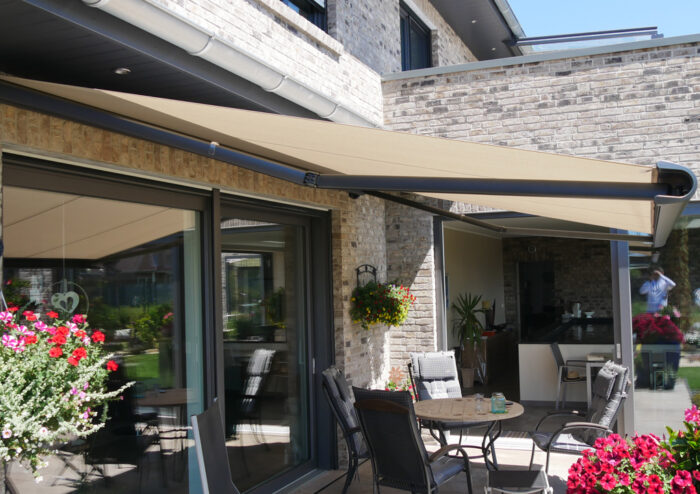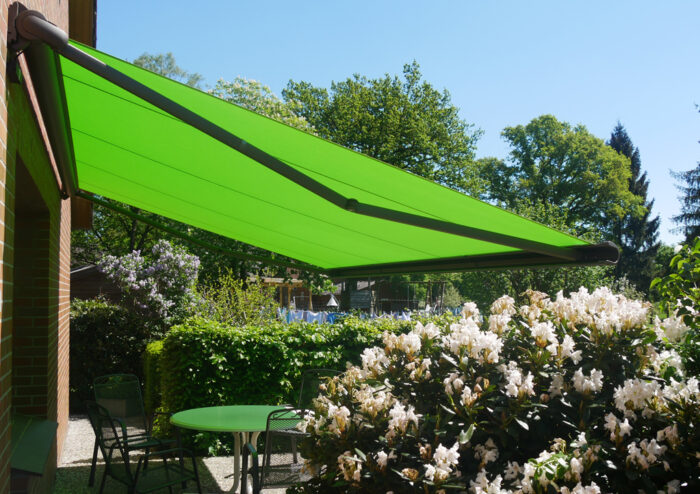
When it comes to creating an outdoor space that you feel proud of, understanding how garden colour theory works is absolutely essential.
Whether you’re looking to learn the basics or just need some colourful garden inspiration, the Open Space Concepts team is here to help with our guide on how to apply colour theory to your garden.
Explore our range of contemporary awnings and bespoke glass rooms for inspiration on how to make the most of your garden space.
Garden Colour Theory: Understanding Basic Colour Principles
Before you can start applying colour theory to your garden, you first need to understand the basics of how colour theory works.
Many people think they have a strong understanding of colour theory, but most struggle when it comes to practical application because they don’t know which colours work well together.
Let’s take a look at the basic principles of the colour wheel, colour harmony, and colour relationships:
Understanding the Colour Wheel
The colour wheel is based on the three primary colours (yellow, red, and blue) and how they can be mixed to create other colours.
Primary colours cannot be mixed from other colours. They are the source of all other colours.
Secondary colours are created by mixing primary colours:
- Orange is created by mixing red and yellow
- Violet is created by mixing blue and red
- Green is created by mixing blue and yellow
Tertiary colours are created by mixing one primary colour with one secondary colour:
- Yellow-orange
- Red-orange
- Red-violet
- Blue-violet
- Blue-green
- Yellow-green

What Is Colour Harmony?
Colour harmony is when colours are arranged in a way that looks pleasing to the eye. Colour harmony creates:
- Balance
- A sense of order
- A sense of excitement (i.e. it is not visually boring to the viewer)
Colours need to be balanced because too much visual stimulation is chaotic and could be offputting to the viewer, especially when it comes to garden design. On the other hand, not enough visual stimulation can also be offputting because it is boring for the viewer to look at.
Colour Relationships: Complimentary vs Analogous Colours
Complimentary colours are opposite each other on the colour wheel. They work together by bringing out the intensity of each other, which makes them popular colour combinations for garden designers.
Analogous colours are next to each other on the colour wheel. When an analogous colour palette is used, it creates a gradation of the same colour that is particularly pleasing to the eye.
Colour Theory in Garden Design: Where Should You Start?
Now that you understand the basics of colour theory, you’re ready to start applying them to your garden space. But where do you begin with picking the perfect colour palette?
The first thing to remember is that there are no right or wrong colours to use in your garden design. The best place to start is by choosing a colour or colours that you like the most and going from there.
However, you also need to consider how the colour you choose will look against your garden landscape.
As a general rule, darker colours will recede into the landscape, while lighter colours will stand out more.
Warm colours like red, yellow, and orange will catch your attention, standing out against the rest of your garden landscape. Warm colours are energising and exciting, effortlessly breathing life into outdoor spaces that feel dull and washed out.
Cool colours like blue, purple, and pink will recede into the landscape and make your garden space look larger, so choosing them is a great trick for people who have small gardens. Cool colours are calming and serene, which makes them ideal for curating a relaxing outdoor space.
Monochromatic colours are great for creating visual unity in your outdoor space. Monochromatic landscapes can be made more visually interesting by using contrasting textures, such as incorporating a wide range of different plants and flowers.
Applying Garden Colour Theory to Your Outdoor Space
At Open Space Concepts, we’re experts in crafting harmonious outdoor spaces that take every aspect of colour theory into consideration.

This sophisticated modern awning uses a neutral colour that matches the furniture and brickwork of the house to create a chic monochromatic look. However, the client has added the warm pink and red hues of the surrounding flower arrangements to compliment these neutral tones, creating an outdoor space that is beautifully cohesive.

This homeowner has chosen a vibrant green colour for their awning, which stands out against the landscape and makes the space look bright and alluring. Bright colours like this illicit a sense of joy and guarantee that your garden will be inviting all year round, even when it’s rainy.

When it comes to our bespoke louvred pergolas and glass rooms, many of our clients opt for a neutral colour palette for that relaxing spa-like feel. This client has added cool blue and pink hues through the use of cushions for a serene and calming look that blends beautifully with the landscape.
Create Your Dream Garden Space with Bespoke Structures from Open Space Concepts
If this introduction to garden colour theory has left you feeling inspired, Open Space Concepts is here to help.
We specialise in the design and installation of bespoke outdoor living structures, each carefully designed to help bring your outdoor space to life.
We’ve installed over 2,000 structures for clients all over the UK, and we’re proud to have hundreds of 5-star reviews to show for it.
Discover our incredible range of case studies or make an enquiry today.
-END-
About
First established in 2018, Open Space Concepts is built on the strong foundations of more than 25 years’ of industry experience, creating and installing the vast majority of structures available today from all over the world. With innovative, bespoke all weather solutions for domestic and commercial properties, Open Space Concepts prides itself on producing the highest quality structures – each proven to last in the hottest summers and the harshest of winters.
Tried, tested and trusted, the team have installed over 2,200 structures for customers up and down the country, which has led them to become one of the most trusted outdoor living compan
